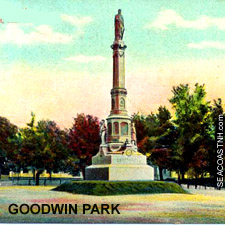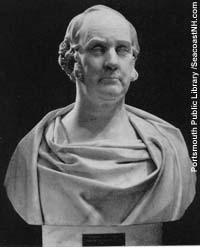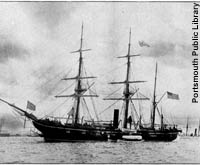| How a Monument Gets Made |

MAKING OF GOODWIN PARK
Monuments are simplified history. They draw attention to events in the past, but do we really pay attention? Here we deconstruct the story of the Soldiers and Sailors Monument in Goodwin Park in Portsmouth, NH. What does it stand for? Who was it built to honor? Who built it? And who is Ichabod Goodwin?
It was literally collapsing into itself. In 1999 when we first explored Portsmouth’s key Civil War monument, the weight of the statue was causing it to cave inward. Amazingly, the "white lead" monument had been designed to as light, mass produced and affordable. But this "MacMonument" was in tough shape after more than 100 years.
Installed in 1888, the so-called Goodwin monument is tucked into an attractive park on Islington Street, once the main road leading into Market Square. Perhaps you've never even noticed it. Recently the ailing park got a $250,000 face-lift courtesy of a federal HUD grant. That's appropriate because, when the park and its large "white bronze" memorial went up in 1888, it didn't cost the city a dime.
Here is the backstory to Goodwin Park and its restored memorial, broken into easy-to-swallow bites. If you wonder where monuments come from – this is how they happen. .
THE MAYOR
Elected officials inevitably worry about their "place in history" and so did Portsmouth Mayor Marcellus Eldredge. Like local tycoon Frank Jones (another Portsmouth mayor), Mr. Eldredge owned a profitable Portsmouth brewery. The Civil War was fresh in the local memory, much as Viet Nam and the Gulf War are today. Mayors all over the North were erecting Civil War monuments. In fact, those who didn't might be considered southern sympathizers. No carpetbagger, Mayor Eldredge promised the local veterans’ group that, if they could raise a few thousand dollars by public conscription, he would pay for the other half of a dandy new monument. No carpetbaggers either, the people of Portsmouth signed up. The smallest recorded donation was a dime from a schoolgirl, the largest was a $1,000 donation from Frank Jones. A company in Bridgeport, Connecticut was then mass producing low cost monuments to fulfill the demand. Made of the revolutionary new "white bronze" alloy, these monuments could be assembled from various parts into a custom-made version. Portsmouth leaders got the catalog and ordered up a fancy one.
THE PARK
But where to put the statue? When Mayor Eldredge could find no suitable piece of city property for a new park, he bought the land himself. The descendants of NH Governor Ichabod Goodwin had a nice plot called Goodwin Field, along what was then a lovely residential street across from the Goodwin family mansion. A private deal was struck with the Goodwins. The city could build a park and raise its monument, it was agreed, but the land would have to remain public for all eternity.
THE MANSION
Most people get confused at this point in the story because the stately Goodwin Mansion no longer looks out over Goodwin Park. There's a one-story brick furniture antiques store there now. That is because the large historic house was broken into three pieces and transported to Strawbery Banke Museum on the other side of town in 1963. Good news the South End, but not so good for the once exclusive tree-lined Islington Street. Like Middle and Pleasant Streets, this was formerly one of the most desirable addresses in Portsmouth, before the coming of urban renewal, gas stations, Dutch elms disease, commercial zoning and convenience stores - -- but that's another story altogether. Built during the War of 1812, the Federalist design of the Goodwin Mansion in all its gubernatorial splendor has been preserved for public viewing.
THE GOVERNOR
 All the pieces were falling nicely together for Mayor Eldrege in 1888. The late Ichabod Goodwin (he died just a few years earlier in 1882) was renowned in Portsmouth as New Hampshire's "Civil War Governor." Eldredge was able to erect his 42-foot Civil War statue in the new Goodwin Park. Goodwin's face was hastily designed into the monument, with the obligatory relief of Abraham Lincoln on the other side. But a few words here about Mr. Goodwin before we continue.
All the pieces were falling nicely together for Mayor Eldrege in 1888. The late Ichabod Goodwin (he died just a few years earlier in 1882) was renowned in Portsmouth as New Hampshire's "Civil War Governor." Eldredge was able to erect his 42-foot Civil War statue in the new Goodwin Park. Goodwin's face was hastily designed into the monument, with the obligatory relief of Abraham Lincoln on the other side. But a few words here about Mr. Goodwin before we continue.
You couldn't find a more fascinating man in local history. Born in South Berwick, Maine, young Ichabod Goodwin was driven to succeed, and came to work in Portsmouth during the city’s hey-day early in the 19th century. Goodwin was only 14 when he arrived. He gained great respect as a sea captain for 20 years, then, still in his 30's became president of: (1) two banks; (2) the Portsmouth Whaling Company; (3) the Portsmouth Steam Company; (4) Portsmouth Gas Company; (5) the Portsmouth Bridge Company and, most importantly, (6) Goodwin was president of the local railroad for two decades. He was such a powerful force in the state that, as governor, he was able to privately raise $650,000 for President Abraham Lincoln's early war effort. The man simply had the Midas Touch. Ironically, it was the industrialization of the West End of Portsmouth under Goodwin that turned the once lovely tree-lined Islington Street into a less attractive and more profitable commercial thoroughfare.
THE BATTLESHIP
 Three sides of Mayor Eldredge's new statue came right out of the foundry company catalog. They included life-sized cannon balls, a large sailor, a minuteman, all capped by an eight-foot "Lady Liberty". Thanks to the French gift of a gigantic statue in New York City, statues of Liberty where then all the rage. Three sides of the monument honored bloody battles at Antietam, Gettysburg and Fredericksburg, but the fourth side was custom built for Portsmouth, NH - home of the USS Kearsage.
Three sides of Mayor Eldredge's new statue came right out of the foundry company catalog. They included life-sized cannon balls, a large sailor, a minuteman, all capped by an eight-foot "Lady Liberty". Thanks to the French gift of a gigantic statue in New York City, statues of Liberty where then all the rage. Three sides of the monument honored bloody battles at Antietam, Gettysburg and Fredericksburg, but the fourth side was custom built for Portsmouth, NH - home of the USS Kearsage.
The Civil War was a boom period for shipbuilding on the Piscataqua. Next to the Merrimack and Monitor submarine attack, no US Civil War sea battle is more famous than the Kearsage sinking the Confederate ship Alabama. Built here at the Navy Yard in 1861, Kearsage was a strange combination of sailing ship and steamboat. The confrontation actually took place off the coast of Europe where the Confederate ship had been stalking Yankee merchant vessels. The Kearsage captain politely allowed Alabama five days to make repairs in a French port before the battle began in July 1884. When they finally faced off, the Alabama was sunk and the Kearsage boasted no lives lost, though one crewman died of his wounds days later.
The one hour and ten minute battle left Kearsage veterans with a lifetime of laurels. Some of the crewmemebrs organized to promote annual Kearsage remembrance ceremonies and marched in local military parades well into World War I era. Around here "Remember the Kearsage!" was a cry more stirring than "Alamo!"
THE MONUMENT
What we see in Goodwin Park today is only a stumpy version of the original statue. It arrived from the factory shortly before the celebration, and the eight-foot Liberty statue (also called "America") was hoisted onto a 15-foot pedestal, fastened to a hollow base on a raised piece of land in Goodwin Park. The touted "white bronze" or zinc alloy turned out to be a wholly unsatisfactory material for monuments. The skin cracked. Water poured in and the supporting skeleton rusted underneath. By 1955 the pedestal was so precariously attached that it was amputated, the cracks filled in with cement and the crowning statue lowered.
A small passageway was cut into the hollow base in the 50s and, with an official Portsmouth City flashlight, SeacaostNH.com was allowed to crawl inside the statue before its restoration in 1999. It was not a stirring vision. The original metal armatures were completely eaten away. The base was bowed at the center, and the guts were a patchwork of tar, cement, caulking compound and rubber sealant. Outside, the Minuteman statue was tilting badly. Bits of the Sailor's cap had eroded away, and Lady Liberty had cracks along her wrist that looked like an attempted suicide. Water still poured in through breaks in the surface. All this was repaired in 2003 and the restored monument re-installed on its original foundation.
THE CELEBRATION
None of this was on the mind of Marcellus Eldresge on July 4, 1888. He was making his indelible mark on history, he thought, with a rock-solid statue. The town turned out in full with an estimated 5,000 outsiders coming in by trains that ran hours late. The visiting NH governor, with a pressing commitment in Amesbury, left before the action even started.
There were the usual military bands, parades and speeches all exhaustingly reported in the Portsmouth newspapers. Crewman from both Kearsage and Alabama were in attendance. Things went swimmingly, except when the drapery covering the monument caught on one of the statues during the unveiling ceremony. A spectator had to climb up the monument to release it so the memorial could be revealed. Police reported few criminal incidents and an uncharacteristic lack of public drunkenness, which often left even very young boys passed out the in the streets after days of public celebration. The ideal day was marred only by the accidental death of boy who had come in from the Isles of Shoals for the festival and was killed during the fireworks display.
THE CODA
During the original research for this article in 1999, we wanted to track down a bust of Governor Ichabod Goodwin. There was one a plaster version at the Portsmouth Athenaeum, but the marble original was then stored under a sheet at the bottom of the stairs in the basement of the Portsmouth Public Library, just up the road from the monument on Islington Street. The bust, when we discovered it, was wearing a plastic construction helmet. Today Gov. Goodwin has been released from the basement and is installed on the second floor of the new Portsmouth Public Library. The governor’s home and garden has been fully restored at Strawbery Banke. A book including the fascinating diaries of the governor’s wife, Sarah Parker Goodwin, has recently been published. And the park and monument, meticulously restored, look better than they ever have.
SOURCES: Ray Brighton, Rambles Around Portsmouth, Peter E. Randall, Publisher, 1974; vertical files at the Portsmouth Athenaeum, City of Portsmouth and Portsmouth Public Library.
Copyright © 1999 SeacoastNH.com. Revised 2007. All rights reserved
